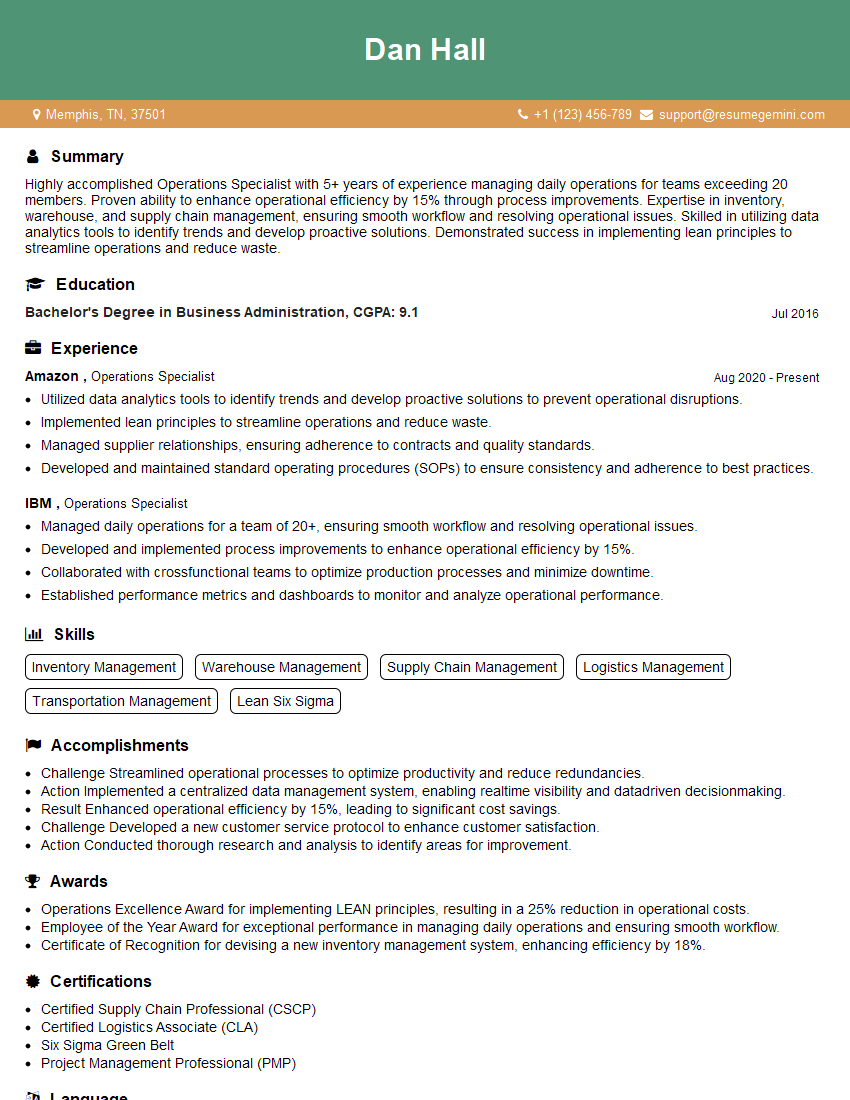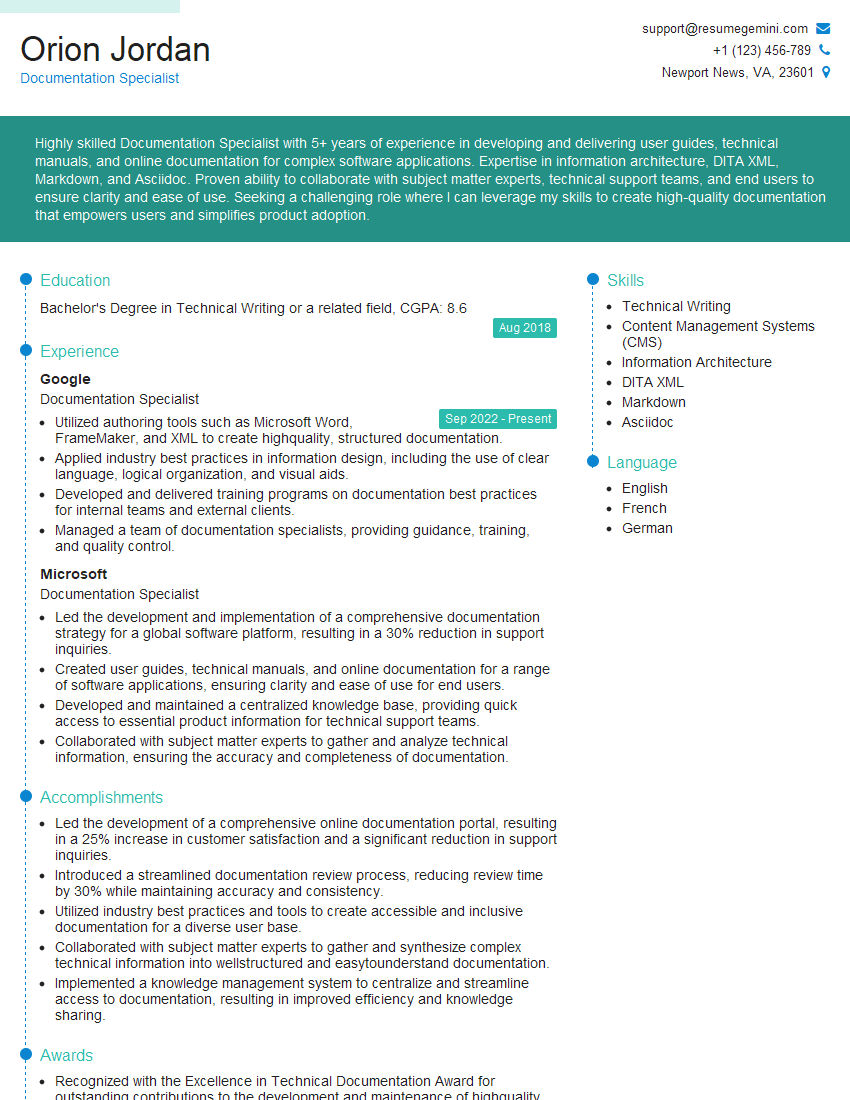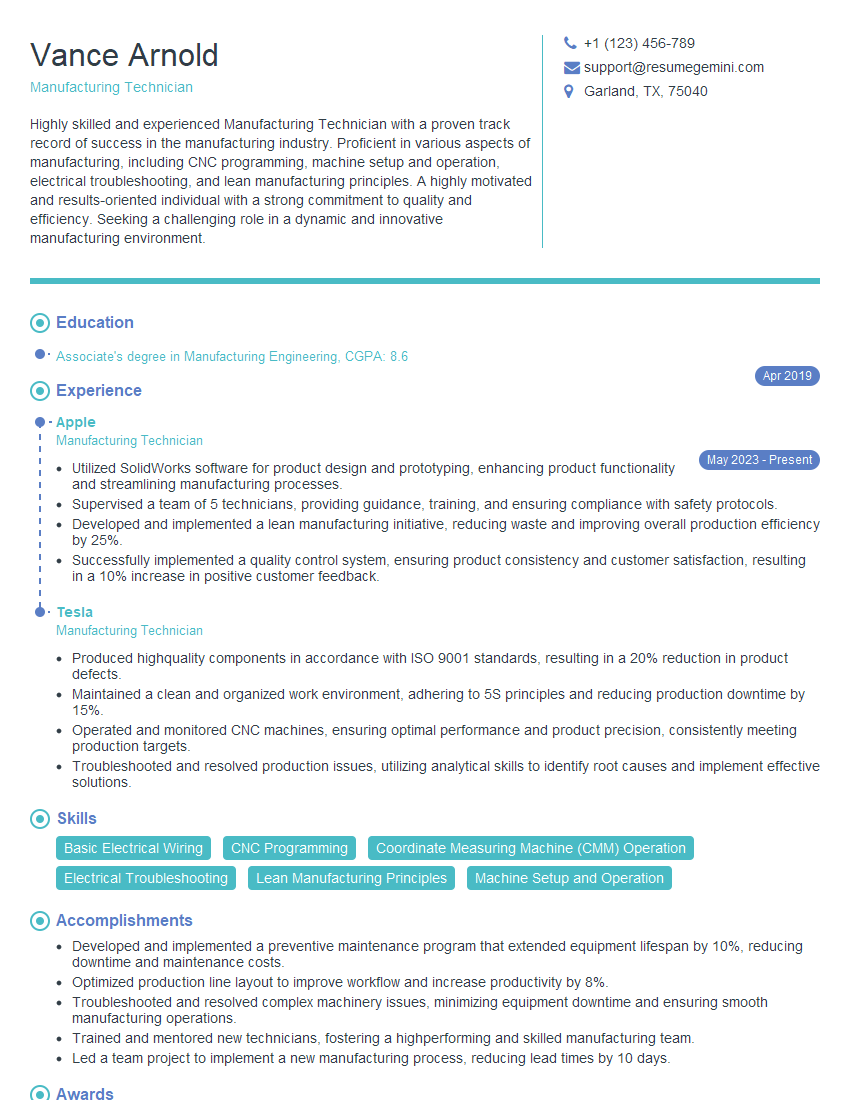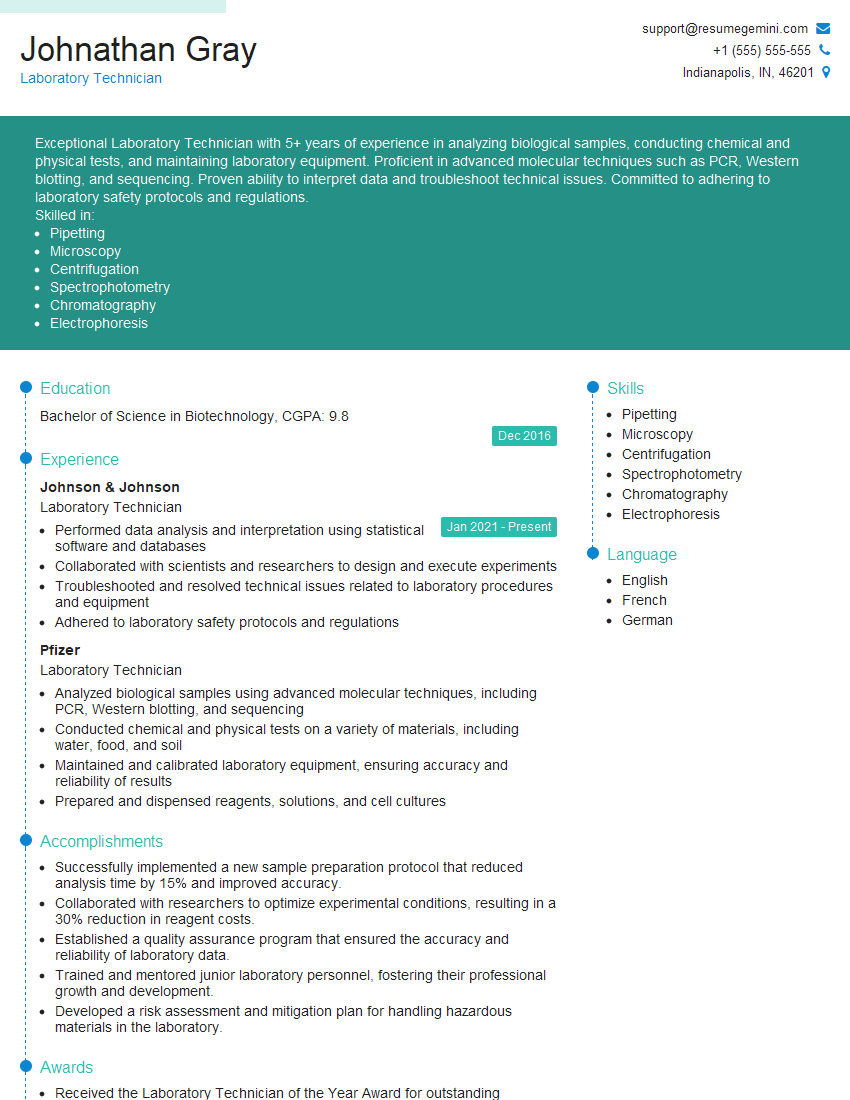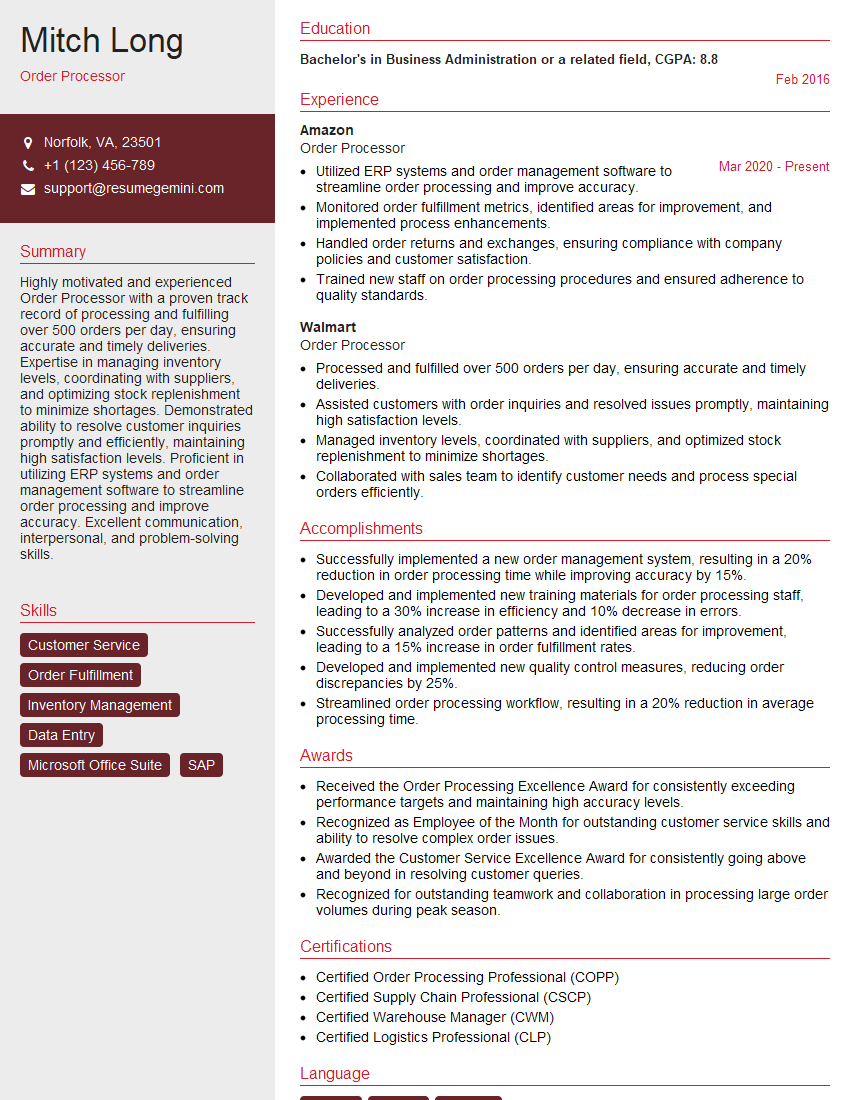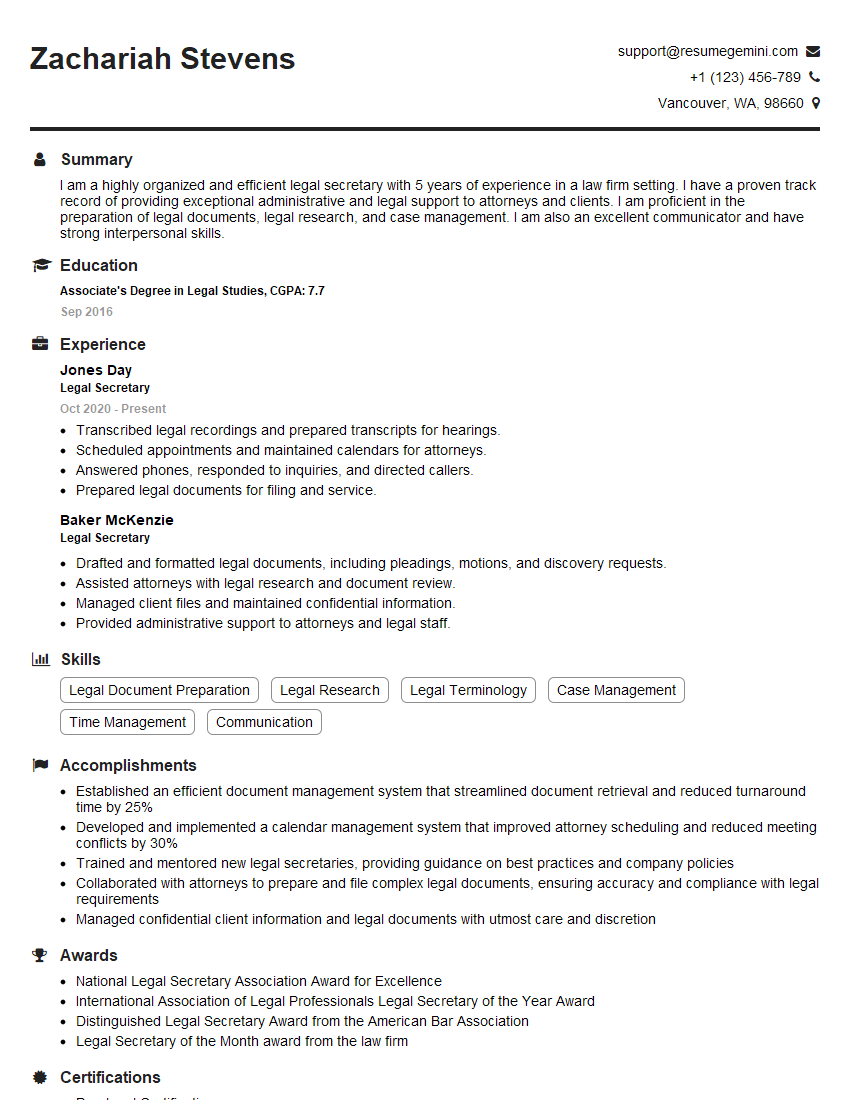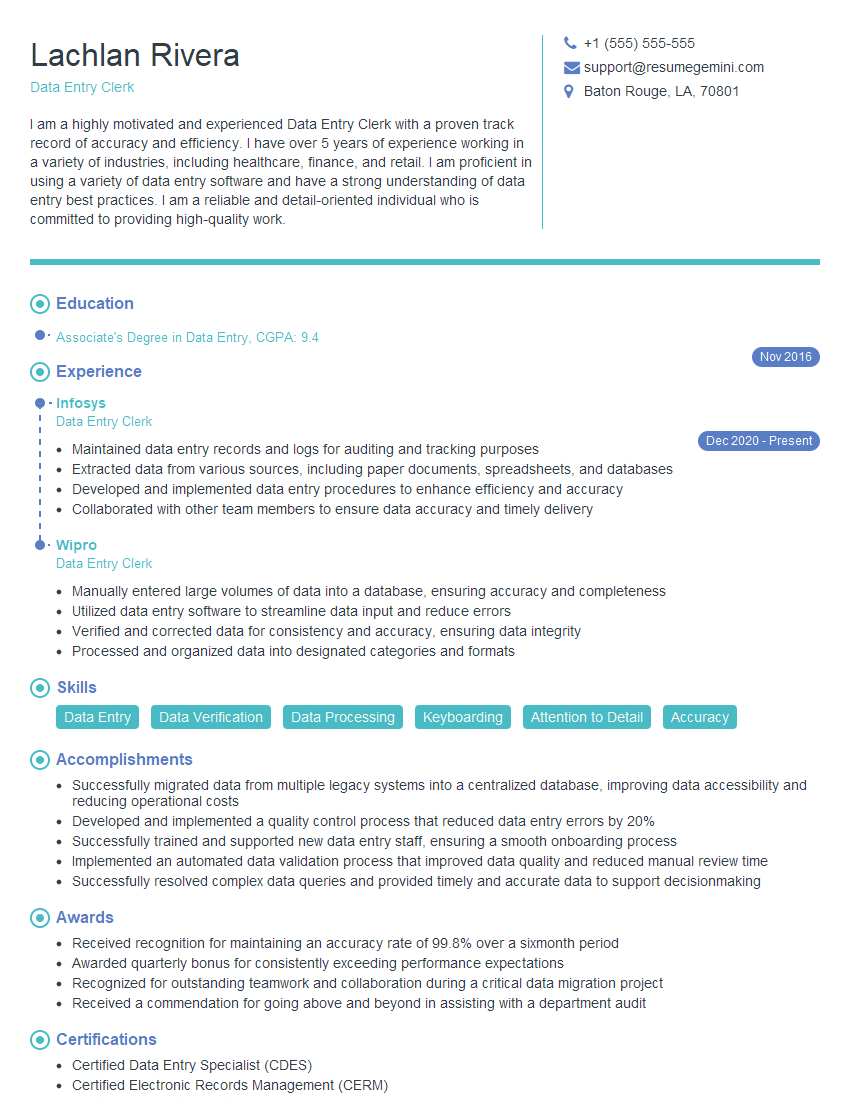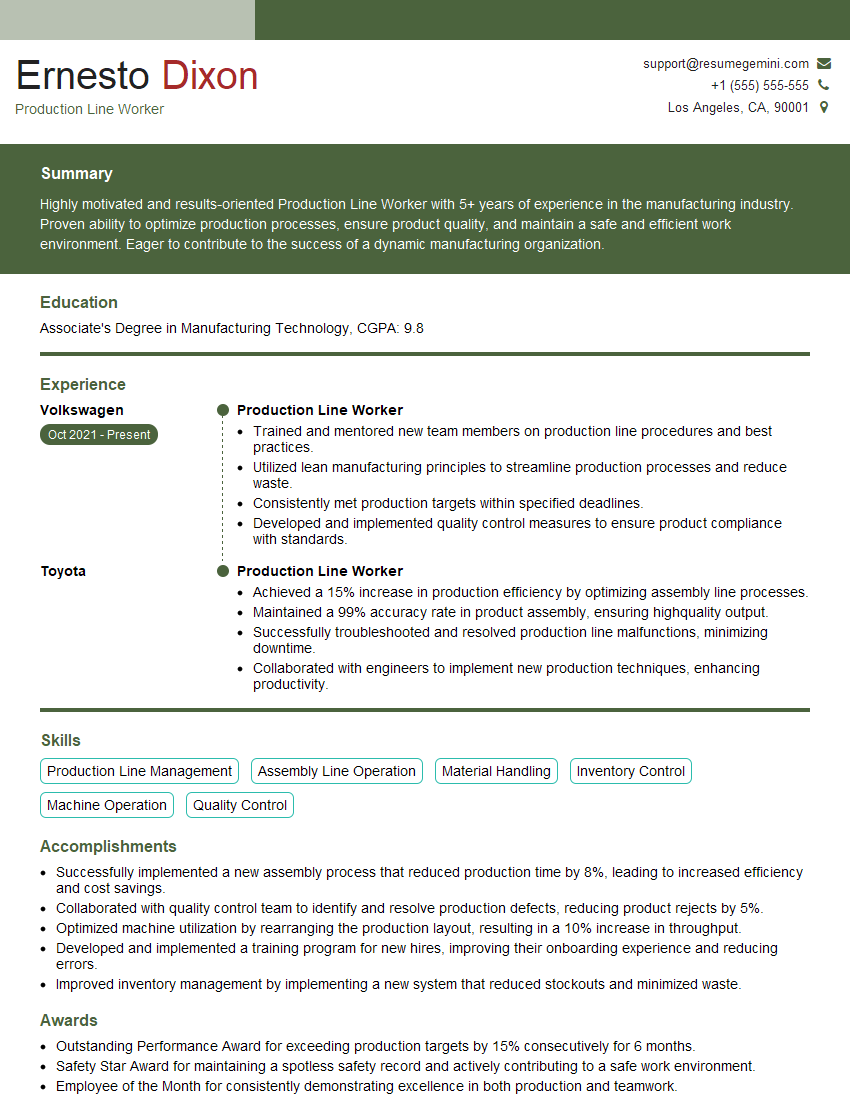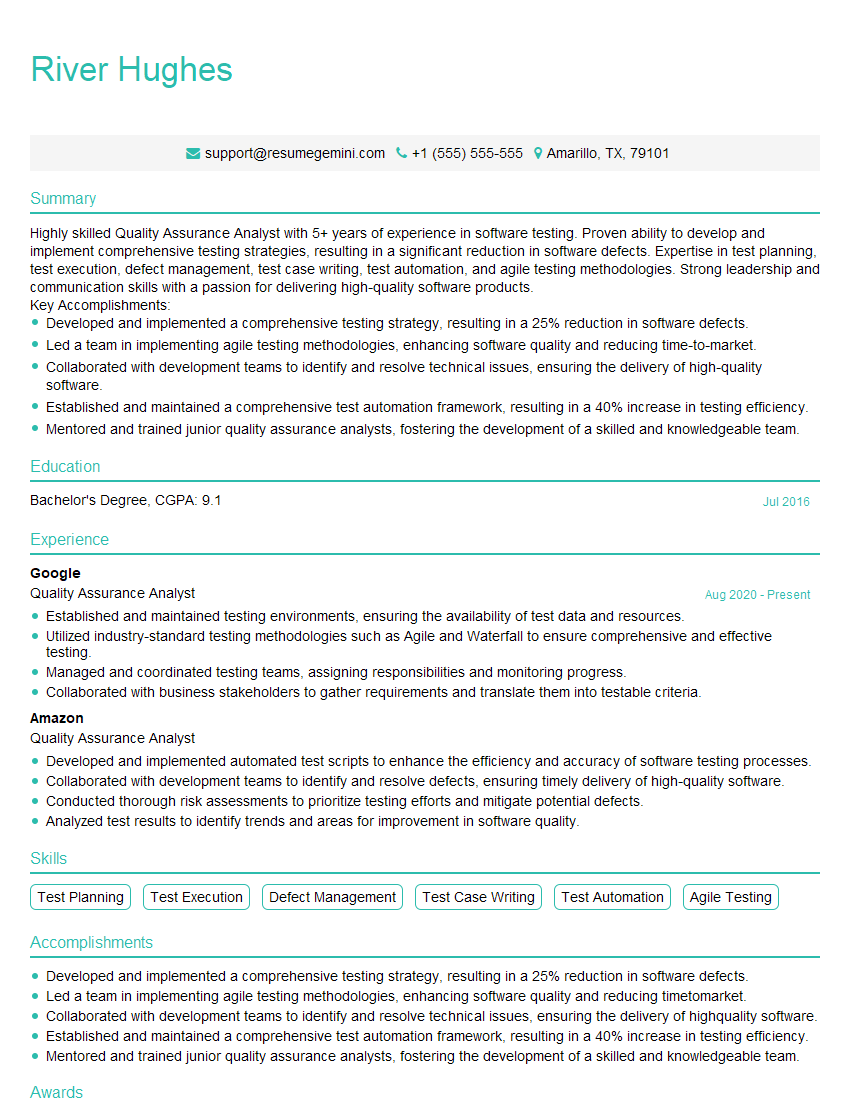Unlock your full potential by mastering the most common Following instructions and procedures interview questions. This blog offers a deep dive into the critical topics, ensuring you’re not only prepared to answer but to excel. With these insights, you’ll approach your interview with clarity and confidence.
Questions Asked in Following instructions and procedures Interview
Q 1. Describe a time you misinterpreted instructions. How did you rectify the situation?
Early in my career, I was tasked with configuring a network server using a provided manual. I misinterpreted a section regarding firewall rules, believing it instructed me to allow all incoming traffic on port 8080. This resulted in a security vulnerability that was thankfully caught during testing.
To rectify the situation, I immediately reviewed the manual again, this time focusing on each instruction, paying attention to the specific port numbers and access permissions. I cross-referenced the manual with online documentation to ensure my understanding was correct. I then corrected the firewall rules, thoroughly tested the changes, and documented the error and correction for future reference. It taught me the importance of meticulous attention to detail and verifying all aspects of an instruction set.
Q 2. How do you handle conflicting instructions from different sources?
Conflicting instructions are a common challenge, especially in collaborative environments. My approach is systematic. First, I identify the source of each instruction – who gave it, their authority level, and the context. Then, I analyze the instructions themselves, looking for common ground or points of disagreement. If the discrepancies are minor, I may choose the option that seems more efficient or less risky.
However, if the conflict is significant or involves contradictory actions, I immediately escalate the issue to the relevant parties. I clearly explain the conflicting instructions, present my analysis, and seek clarification to establish a unified set of instructions. This ensures everyone is on the same page and avoids potentially serious errors. I also document the conflict and the resolution for future reference, ensuring clarity and accountability.
Q 3. Explain your process for verifying the accuracy of instructions before proceeding.
Verifying the accuracy of instructions is paramount to preventing errors. My process involves several steps. First, I read the instructions thoroughly and make sure I understand each step. I then cross-reference them with any relevant documentation or established procedures. If there are any ambiguities or unclear parts, I ask for clarification from the source or consult related resources.
Next, I look for potential conflicts or inconsistencies within the instructions themselves. If a step seems illogical or unsafe, I pause and seek clarification. If possible, I also conduct a dry run or simulation of the procedure before actual implementation. Finally, I document my verification process so that my steps are auditable and can serve as a reference for future work. This methodical approach ensures accuracy and minimizes the risk of misinterpretations.
Q 4. What steps do you take to ensure you understand complex procedures?
Understanding complex procedures requires a structured approach. I start by breaking down the procedure into smaller, more manageable steps. This helps me grasp the individual components before understanding the overall process. Then, I use visual aids like flowcharts or diagrams to map out the steps and their relationships. Visualizing the process makes it easier to identify dependencies and potential bottlenecks.
I also look for analogies or comparisons to similar procedures that I already understand. This helps relate the new procedure to familiar concepts, making it easier to grasp. I often use active learning techniques, like teaching the procedure to someone else or performing a practice run. Finally, if necessary, I reach out to experts or colleagues for clarification on any confusing aspects. This multi-faceted approach ensures a clear and comprehensive understanding of complex procedures.
Q 5. How do you prioritize tasks when given multiple instructions simultaneously?
Prioritizing tasks when faced with multiple instructions requires a clear strategy. I use a combination of methods to effectively manage this. First, I identify the urgency and importance of each instruction, often using a matrix that considers both factors (urgent/important, important/not urgent, etc.). This helps categorize tasks and assign priorities.
Next, I estimate the time required for each task and create a realistic schedule. This ensures I allocate sufficient time to each instruction without overloading myself. If the tasks are interdependent, I sequence them logically, prioritizing those that need to be completed first to enable others. I also utilize tools like task management software to track progress and ensure accountability. This structured approach ensures efficient execution while maintaining a high level of accuracy.
Q 6. Describe a time you had to follow a procedure you found inefficient. What did you do?
I once had to follow a lengthy, outdated inventory management procedure involving manual spreadsheets and paper-based tracking. The process was inefficient and time-consuming. After thoroughly documenting the procedure as is, I proposed improvements.
My suggestion was to implement a database-driven inventory system. This involved creating a proposal detailing the benefits of such a system – increased efficiency, reduced errors, better reporting capabilities, and a significant time saving. I presented my proposal, showcasing the potential cost savings and productivity gains. After securing approval, I oversaw the implementation and training on the new system. It resulted in a more efficient and streamlined process for everyone involved.
Q 7. How do you manage your time effectively when working with detailed procedures?
Managing time effectively with detailed procedures involves planning and organization. I start by breaking down the procedure into smaller, manageable tasks, estimating the time required for each. This allows for more accurate time allocation and avoids overestimation or underestimation. I then create a realistic schedule, prioritizing tasks based on urgency and dependencies. Using a calendar or task management tool helps visually track progress and identify potential bottlenecks.
Throughout the process, I maintain regular check-ins to monitor my progress and adjust the schedule as needed. I also prioritize taking short breaks to avoid burnout and maintain focus. By following a structured approach and using time management tools, I can efficiently manage complex procedures while maintaining accuracy and avoiding delays.
Q 8. How do you handle unexpected challenges while following established procedures?
Unexpected challenges are inevitable when following procedures. My approach involves a structured process. First, I assess the nature of the challenge: Is it a minor deviation, a significant obstacle, or a complete breakdown of the procedure? I then refer to the procedure itself – many include contingency plans or escalation paths for unusual situations. If the procedure doesn’t offer guidance, I prioritize safety and data integrity. This might involve pausing the process to consult with a supervisor or a more experienced colleague to find a solution that aligns with established best practices. For example, if a software program crashes mid-process and the procedure doesn’t account for this, I wouldn’t blindly retry without documenting the issue and seeking help to prevent data loss or corruption. The key is to document every step taken, including the challenge encountered, the actions undertaken, and the outcome, to improve procedures in the future.
Q 9. Have you ever had to deviate from a procedure due to safety concerns? Explain.
Yes, absolutely. Safety is always paramount. During a quality control check on a manufacturing line, I noticed a machine operating outside its specified parameters, posing a potential risk of malfunction. The established procedure called for continuing the process. However, I deviated from the procedure and immediately shut down the machine. I documented my actions thoroughly, explaining the safety concern and why I deviated. My supervisor confirmed my decision was correct and appreciated my proactive approach to risk management. This highlights the importance of understanding that procedures are guidelines, and safety overrides any written instruction if a real-time hazard is detected.
Q 10. Describe your experience working with standard operating procedures (SOPs).
I have extensive experience working with SOPs, from developing them to meticulously following them. In my previous role, I was responsible for updating and improving the SOPs for our lab testing procedures. This involved reviewing existing documents, identifying areas for improvement, and collaborating with colleagues to create clear, concise, and unambiguous instructions. We used a version-control system to track changes, ensuring everyone was working with the most up-to-date version. Moreover, I’ve consistently applied SOPs in various settings, from data entry to complex scientific experiments. The key is understanding that SOPs are not just documents; they’re tools to ensure quality, consistency, and safety. The more I understand the ‘why’ behind each step, the better I can anticipate and handle deviations.
Q 11. How do you ensure compliance with regulations and guidelines in your work?
Compliance is crucial. I achieve this through several strategies. First, I ensure I’m thoroughly familiar with all relevant regulations and guidelines, regularly reviewing them and asking for clarifications when necessary. I also participate in any compliance training provided by the company and maintain detailed records of my participation. Secondly, I always cross-check my work against the regulations and guidelines. If I encounter any discrepancies, I report them promptly to the appropriate authorities. Thirdly, I adopt a proactive approach, anticipating potential compliance issues and implementing preventative measures before they arise. Think of it like a pilot conducting pre-flight checks; consistent review and preventative measures minimise problems before they become critical.
Q 12. How do you document your adherence to procedures?
Documentation is vital for demonstrating compliance and providing an audit trail. My approach involves meticulous record-keeping. This includes maintaining detailed logs of all procedures followed, dates, times, any deviations from the standard procedure (with justifications), and the names of individuals involved. I use a variety of methods, including electronic logs, laboratory notebooks, and checklist forms – whichever is most appropriate for the specific process. In some cases, this also includes capturing screenshots or digital signatures to ensure complete accountability and traceability. This comprehensive approach ensures that my adherence to procedures is transparent and verifiable.
Q 13. How do you stay updated on changes to procedures or instructions?
Staying current with procedure changes requires proactive engagement. I typically subscribe to relevant newsletters or announcements from my company or professional organizations. Many organizations use internal communication systems (e.g., intranets or email distribution lists) to disseminate updates on SOPs. I regularly check these channels for updates. I also attend relevant training sessions and workshops. In some instances, direct communication with supervisors or managers ensures I’m immediately aware of any critical changes. It’s like keeping your software up-to-date; regular updates ensure you’re working with the latest and most efficient tools.
Q 14. What strategies do you use to maintain accuracy and consistency when following procedures?
Maintaining accuracy and consistency requires a multi-faceted approach. First, I always carefully read and understand the procedure before I begin. I create checklists to ensure I follow each step precisely. Secondly, I use standardized equipment and methodologies to minimize errors. Thirdly, I implement regular self-checks and cross-referencing. For instance, comparing data against expected values or double-checking calculations. Finally, I embrace continuous improvement by analyzing past performance and identifying areas where my accuracy or consistency can be enhanced. Accuracy and consistency are like baking a cake – the precise measurement and meticulous following of the recipe ensures a consistently perfect result.
Q 15. Describe your experience working with detailed manuals or instructions.
Throughout my career, I’ve extensively worked with detailed manuals and instructions, ranging from complex technical documents for software implementation to intricate safety protocols in manufacturing. My experience encompasses various formats, including written guides, interactive tutorials, and even video demonstrations. I’m adept at navigating highly technical language and breaking down complex information into manageable steps.
For example, in my previous role at Acme Corp, I was responsible for configuring network infrastructure. The vendor’s installation manual was over 200 pages long, filled with technical jargon and diagrams. I systematically worked through each section, making notes, creating checklists, and even building a visual flowchart to guide the process. This methodical approach ensured a smooth and error-free installation.
Another example involves safety procedures in a laboratory setting. I meticulously followed detailed protocols for handling hazardous materials, ensuring strict adherence to every step to maintain a safe working environment. This included understanding the safety data sheets (SDS) for each chemical and following specific waste disposal procedures.
Career Expert Tips:
- Ace those interviews! Prepare effectively by reviewing the Top 50 Most Common Interview Questions on ResumeGemini.
- Navigate your job search with confidence! Explore a wide range of Career Tips on ResumeGemini. Learn about common challenges and recommendations to overcome them.
- Craft the perfect resume! Master the Art of Resume Writing with ResumeGemini’s guide. Showcase your unique qualifications and achievements effectively.
- Don’t miss out on holiday savings! Build your dream resume with ResumeGemini’s ATS optimized templates.
Q 16. How do you handle situations where instructions are unclear or ambiguous?
When encountering unclear or ambiguous instructions, my first step is to carefully review the document for any additional context. I look for definitions of terms, cross-references, or accompanying diagrams that might clarify the meaning. If the ambiguity persists, I employ a structured approach:
- Seek Clarification: I directly contact the author or relevant expert to seek clarification. This ensures I’m on the right track and prevents potential errors caused by misinterpretations.
- Consult Related Resources: I research similar procedures or standards to gain additional insight. This could involve referring to online documentation, industry best practices, or internal knowledge bases.
- Test and Iterate: In some cases, I may perform a test run using my interpretation of the instructions. If the results are unexpected or incorrect, this immediately highlights the ambiguity, allowing me to re-evaluate and seek further guidance.
For instance, if a software manual mentions a ‘default configuration file’ without specifying its location, I wouldn’t simply guess. I’d actively search for it within the software directory, consult the software’s help files, or reach out to the technical support team for the precise location.
Q 17. How do you ensure you’ve thoroughly understood instructions before starting a task?
Thorough comprehension is paramount. My approach involves a multi-step process:
- Preliminary Review: I start with a quick overview of the entire document to understand the overall scope and objective.
- Detailed Reading: I meticulously read each section, paying close attention to key terms, diagrams, and warnings.
- Note-Taking and Summarization: I create concise summaries, highlighting critical steps, potential pitfalls, and any questions I might have.
- Verification: If possible, I perform a ‘dry run’ without actually executing the task, mentally stepping through each stage to identify any potential problems.
- Questioning: I don’t hesitate to ask clarifying questions if any ambiguity remains. Proactive questioning saves time and prevents errors down the line.
Think of assembling furniture from IKEA. I wouldn’t just start screwing things together. I’d meticulously review the instructions, identify all the parts, and lay them out before beginning assembly. This prevents frustration and ensures a correctly assembled product.
Q 18. How do you identify potential risks or problems while following procedures?
Identifying potential risks and problems is crucial. My process involves:
- Risk Assessment: I systematically evaluate each step in the procedure, considering potential hazards, limitations, and dependencies.
- Dependency Analysis: I identify any steps that rely on previous steps or external factors. A failure in one step could cascade and affect subsequent steps.
- Contingency Planning: I develop alternative strategies or backup plans in case unexpected issues arise. This might include having alternative tools or resources readily available.
- Error Checking: I incorporate built-in checks or validation points at various stages to ensure accuracy.
For example, in a software development workflow, if a procedure requires accessing a remote database, I’d account for network outages or database unavailability. My contingency plan might involve using a local copy of the data or delaying the task until the database is accessible.
Q 19. Describe a time you identified an error in a procedure. How did you handle it?
During a laboratory experiment, I discovered a crucial error in the established procedure for a titration. The protocol incorrectly specified the concentration of a reagent. Following the procedure verbatim would have resulted in inaccurate results and potentially compromised the experiment’s validity.
My response involved:
- Documentation: I meticulously documented the discrepancy, including the page number, the incorrect information, and my proposed correction.
- Verification: I cross-referenced the protocol with other reliable sources, such as published research papers or reputable chemistry handbooks, to confirm my finding.
- Communication: I immediately informed my supervisor about the error and presented my findings and proposed solution. We then discussed the best course of action.
- Correction: With my supervisor’s approval, we corrected the protocol, ensuring the accuracy of future experiments.
This instance highlighted the importance of critical thinking and proactive error detection. Had I simply followed the incorrect instructions blindly, the consequences could have been significant.
Q 20. How do you handle interruptions while following a complex procedure?
Handling interruptions during complex procedures requires careful planning and disciplined execution. My strategy involves:
- Prioritization: I assess the urgency of the interruption. If it’s non-critical, I defer it until I can complete the current procedure step.
- Documentation: Before responding to an interruption, I meticulously document my current position within the procedure. This allows me to seamlessly resume where I left off.
- Mental Checklist: I keep a mental checklist of the steps I’ve already completed and those remaining. This helps me avoid mistakes caused by fragmented attention.
- Communication: If the interruption requires my immediate attention, I politely explain that I’m in the middle of a critical process and will address it as soon as feasible.
Imagine performing a delicate surgical procedure. An interruption requires immediate attention, yet maintaining focus on the primary task is critical. By strategically managing interruptions, I prevent errors and ensure the success of the process.
Q 21. How do you approach learning new procedures and instructions quickly?
Rapidly learning new procedures requires a systematic and efficient approach:
- Active Reading: I actively engage with the material, highlighting key points, making notes, and summarizing concepts in my own words.
- Visual Aids: I utilize diagrams, flowcharts, or mind maps to visually represent the information, improving comprehension and retention.
- Hands-on Practice: I prioritize hands-on practice, even with simulated scenarios. This allows me to solidify my understanding and identify potential challenges.
- Seek Mentorship: If possible, I collaborate with experienced colleagues who can guide me through the process and provide insights.
- Feedback and Iteration: I actively seek feedback on my understanding and performance, refining my approach based on this input.
Learning a new programming language is a great example. I’d start by reading the documentation, then write simple programs, seek feedback from online communities or experienced programmers, and iterate my learning based on the feedback received.
Q 22. What steps do you take to ensure you are following instructions correctly in a high-pressure environment?
In high-pressure situations, accurately following instructions is paramount. My approach is multifaceted and prioritizes clarity, verification, and a methodical approach. First, I ensure I completely understand the instructions before beginning. This often involves reading them multiple times, actively highlighting key steps, and identifying potential ambiguities. Then, I break down the instructions into smaller, more manageable tasks. This allows me to focus on one step at a time, reducing the overall feeling of being overwhelmed. I also utilize visual aids like flowcharts or diagrams, if applicable, to visualize the process and maintain a clear mental picture. Finally, I incorporate regular checkpoints to ensure I’m on track and haven’t missed any critical steps. This could involve comparing my progress against the instructions or seeking feedback from a colleague if possible.
For instance, during a recent emergency system failure, I calmly followed this procedure. I read the troubleshooting guide multiple times, highlighting key diagnostic codes and steps. Then, I methodically checked each component as instructed before moving on. This deliberate approach allowed me to identify the failing component and restore service within the allotted timeframe, even amidst the heightened stress.
Q 23. Describe your experience using checklists or other tools to ensure adherence to procedures.
Checklists and similar procedural tools are invaluable for ensuring adherence. I’ve extensively used checklists in various roles, from IT troubleshooting to laboratory experiments. These tools provide a structured, step-by-step guide, minimizing the chances of overlooking critical steps. Before starting any task using a checklist, I meticulously review it, ensuring I understand every step and potential contingency. I then systematically check off each completed step, using a distinct mark to indicate completion. This creates a visual record of my progress, making it easy to track where I am in the procedure and easily identify any missed or incomplete steps. Furthermore, I often annotate the checklist with any observations or deviations that occur during execution.
In one project, involving software deployment, a detailed checklist prevented a significant error. By systematically following the steps, I identified a minor configuration issue early on, averting a potential system crash later in the process. The ability to immediately see that a certain configuration setting required adjustment thanks to the checklist saved significant time and prevented larger complications.
Q 24. How do you seek clarification if you are unsure about a specific instruction?
If I’m unsure about an instruction, I prioritize proactive clarification rather than making assumptions. My first step is to carefully re-read the instructions, searching for context clues or definitions. I then try to find supporting documentation such as training manuals or process guides, as this often addresses many common queries. If this still leaves me unclear, I directly contact the appropriate supervisor or team member, explaining my uncertainties clearly and concisely. I always record the clarification received, adding it to my notes or the relevant documentation for future reference. It’s crucial to confirm the meaning and ensure that my understanding aligns with the intention behind the instructions. Seeking clarity promptly prevents costly mistakes, ensures efficiency, and maintains a high level of accuracy.
For example, during a recent project, I encountered an ambiguous instruction about data formatting. Rather than guessing, I emailed my supervisor with a specific question about the intended format. This proactive approach ensured we were on the same page, prevented rework, and accelerated the project timeline.
Q 25. How do you organize your work to ensure you follow the correct steps in a procedure?
Organizing my work to follow procedures efficiently involves a multi-pronged approach. Firstly, I prioritize understanding the overall objective of the procedure. This helps me see the bigger picture and how individual steps contribute to the final outcome. Secondly, I break down the procedure into smaller, logically ordered tasks. This makes the process less daunting and easier to manage. This is especially important for complex procedures. I frequently use tools like Kanban boards or to-do lists to visually track my progress and ensure I’m working through the steps in the correct order. Finally, I maintain detailed notes throughout the process, documenting key decisions, adjustments, and any unexpected issues encountered. This structured approach maintains consistency and accuracy and ensures that if I need to pause or return to the task later, I can easily pick up from where I left off.
For instance, in a recent lab experiment, I organized my work using a detailed protocol checklist and a step-by-step notebook. This methodical approach resulted in a smooth, error-free experiment, and the documentation assisted in reporting findings. The clear organization also allowed me to troubleshoot easily when minor deviations occurred.
Q 26. How do you use feedback to improve your adherence to instructions and procedures?
Feedback is essential for continuous improvement in following instructions and procedures. I actively solicit feedback from supervisors and colleagues after completing tasks. I listen attentively, taking notes on areas for improvement. Constructive criticism is invaluable; I analyze it to understand where I may have deviated from procedures or where my understanding was lacking. I then incorporate this feedback into my future workflows, adjusting my approach to minimize similar errors. Self-reflection is also crucial; I review my own performance, identifying patterns or weaknesses in my approach to procedural adherence. By constantly seeking feedback and implementing changes, I ensure consistent improvement in my accuracy and efficiency.
In a recent project involving data analysis, feedback highlighted a minor oversight in my calculations. Recognizing my mistake, I incorporated the feedback to develop a refined checklist for future data processing, reducing the likelihood of similar issues in the future.
Q 27. Describe a time you successfully followed complex instructions to achieve a positive outcome.
During my previous role, I was tasked with configuring a complex network system involving multiple servers and intricate security protocols. The instructions were extensive and highly technical, involving detailed command-line configurations and multiple stages of testing. Following a methodical approach, I broke down the overall configuration into manageable phases. I created detailed checklists for each phase, ensuring that each step was meticulously followed. I utilized diagnostic tools at each stage to validate successful completion and identify potential issues early on. Throughout the process, I maintained comprehensive notes, documenting each step, troubleshooting activities, and any deviations from the standard procedure. The result was a flawlessly configured network, meeting all specified performance requirements and security standards without any critical errors. The successful completion of this task highlighted the importance of meticulous planning, systematic execution, and thorough documentation in managing complex procedural tasks.
Key Topics to Learn for Following Instructions and Procedures Interview
- Understanding Instructions: Learn to dissect instructions, identifying key verbs, nouns, and qualifying phrases to ensure complete comprehension. Practice actively listening and asking clarifying questions when necessary.
- Prioritization and Sequencing: Develop strategies for prioritizing tasks based on urgency and importance. Master techniques for sequencing steps logically and efficiently, avoiding errors from incorrect order.
- Attention to Detail: Explore practical techniques for maintaining focus and accuracy throughout the process. Discuss strategies for error detection and prevention, including double-checking and using checklists.
- Adaptability and Problem-Solving: Practice handling unexpected challenges or deviations from the standard procedure. Develop solutions for common problems and demonstrate flexibility in adjusting to changing instructions or circumstances.
- Documentation and Record Keeping: Understand the importance of meticulous record keeping, including accurate documentation of steps taken and results obtained. Discuss different methods for documenting procedures, such as written logs or digital systems.
- Communication and Collaboration: If the role involves teamwork, practice communicating effectively with colleagues, seeking clarification, and providing updates on progress. Discuss strategies for collaborative problem-solving within a team setting.
- Safety Procedures (if applicable): If the role involves safety-sensitive tasks, thoroughly review and understand all relevant safety procedures and regulations. Be prepared to discuss your approach to safety and risk mitigation.
Next Steps
Mastering the ability to follow instructions and procedures is paramount for success in almost any professional environment. It demonstrates reliability, attention to detail, and a commitment to accuracy – qualities highly valued by employers. To significantly boost your job prospects, create an ATS-friendly resume that highlights these skills effectively. ResumeGemini is a trusted resource to help you build a professional and impactful resume that showcases your abilities. Examples of resumes tailored to emphasize “Following Instructions and Procedures” are available to help guide you.
Explore more articles
Users Rating of Our Blogs
Share Your Experience
We value your feedback! Please rate our content and share your thoughts (optional).
What Readers Say About Our Blog
Hello,
We found issues with your domain’s email setup that may be sending your messages to spam or blocking them completely. InboxShield Mini shows you how to fix it in minutes — no tech skills required.
Scan your domain now for details: https://inboxshield-mini.com/
— Adam @ InboxShield Mini
Reply STOP to unsubscribe
Hi, are you owner of interviewgemini.com? What if I told you I could help you find extra time in your schedule, reconnect with leads you didn’t even realize you missed, and bring in more “I want to work with you” conversations, without increasing your ad spend or hiring a full-time employee?
All with a flexible, budget-friendly service that could easily pay for itself. Sounds good?
Would it be nice to jump on a quick 10-minute call so I can show you exactly how we make this work?
Best,
Hapei
Marketing Director
Hey, I know you’re the owner of interviewgemini.com. I’ll be quick.
Fundraising for your business is tough and time-consuming. We make it easier by guaranteeing two private investor meetings each month, for six months. No demos, no pitch events – just direct introductions to active investors matched to your startup.
If youR17;re raising, this could help you build real momentum. Want me to send more info?
Hi, I represent an SEO company that specialises in getting you AI citations and higher rankings on Google. I’d like to offer you a 100% free SEO audit for your website. Would you be interested?
Hi, I represent an SEO company that specialises in getting you AI citations and higher rankings on Google. I’d like to offer you a 100% free SEO audit for your website. Would you be interested?
good


